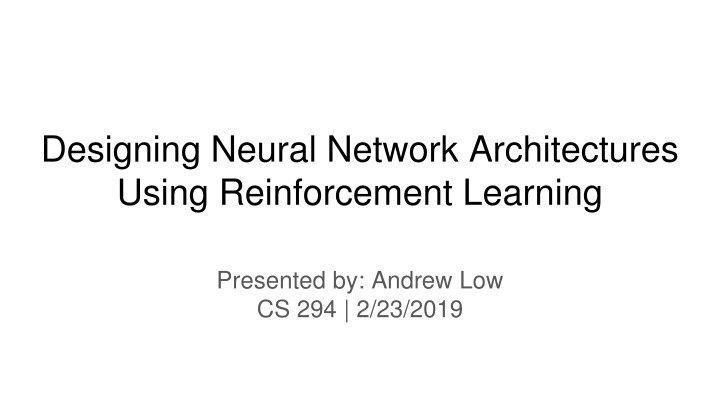
Efficient Neural Network Architecture Design using Reinforcement Learning
Exploring the use of Reinforcement Learning for optimizing neural network architectures to tackle the challenge of efficiently finding optimal designs. This approach aims to streamline the process and enhance performance.
Download Presentation

Please find below an Image/Link to download the presentation.
The content on the website is provided AS IS for your information and personal use only. It may not be sold, licensed, or shared on other websites without obtaining consent from the author. If you encounter any issues during the download, it is possible that the publisher has removed the file from their server.
You are allowed to download the files provided on this website for personal or commercial use, subject to the condition that they are used lawfully. All files are the property of their respective owners.
The content on the website is provided AS IS for your information and personal use only. It may not be sold, licensed, or shared on other websites without obtaining consent from the author.
E N D
Presentation Transcript
Designing Neural Network Architectures Using Reinforcement Learning Presented by: Andrew Low CS 294 | 2/23/2019
Outline Problem 3 Background 5 Reformulating the Problem 9 Key Results 14 Improvements and Limitations 17 Discussion and Impact 18
Context Neural Networks are powerful and increasingly popular Many different network architectures exist - without a clear winner Architecture depends on the domain
Problem Convolutional neural network architecture design today - - Large search space Most novel architectures are hand-designed, motivated by theoretical insights and experimental intuition of experts Slow and expensive! - How to efficiently find optimal neural net architectures?
Background - Reinforcement Learning Recap State space S, action space U, and reward distribution R. Rewards may be delayed and/or sparse - require a sequence of correct actions Goal: Find the optimal policy that maximizes our expected reward (Find optimal path on a MDP with a finite horizon)
Background - Q Learning Difficult to know the actual value function, so we approximate the value function using Q values Model free and Off-policy As the agent explores the state and action spaces, it learns about its environment and retains that knowledge via Q values
Background - Exploration and Exploitation Exploration: when an agent tries new actions and states to learn about its environment Exploitation: when an agent utilizes what it knows to take the best path possible Too much exploration -> slow convergence Too much exploitation -> converge to local optima -learning: Higher means more exploration
Background - Experience Replay Generating data for reinforcement learning can be costly - and many RL algorithms require lots of data We store each (state, action, reward, new state) in a database Can then replay past experiences by randomly sampling from the database
Reformulating the Problem The key innovation is to reformulate the network architecture search as a reinforcement learning task! - - - State space: all possible neural net architectures Action space: choosing new layers (conv, FC, pool) to put in the network Reward function: the validation accuracy of the complete model
Reformulating the Problem Key Assumption - a well-performing layer in one network will also perform well in a different network State space - Neural net architectures that can be built using the following layer types: Convolution, Pooling, Fully Connected, Global Average Pooling, and ReLU Termination states are GAP and Softmax
Reformulating the Problem Action Space - the set of possible layers we can put at the next level. The authors place restrictions on the action space for tractability - - - Maximum network depth Representation size Layer order Consecutive Pooling layers - Transitioning to FC layers Number of FC layers - -
Experimental Setup Models were trained with the Adam optimizer Top ten models were selected and fine tuned further 3 Datasets: - - - MNIST CIFAR 10 SVHN
Experimental Setup - Details Each model trained with Adam optimizer Q-learning rate alpha = 0.01 Epsilon transitions from 1 -> 0.1 Utilizes experience replay to save time 1 = 0.9, 2 = 0.999, = 10 8 Batch size: 128, Learning rate = 0.001
Key Results MetaQNN models outperformed CNNs that only used the same layer types
Key Results MetaQNN models performed worse than but still at a competitive level compared to than state-of-the-art models that utilize more complex layers and training methods.
Key Results MetaQNN models outperformed other automated network design protocols CIFAR-10 MNIST MetaQNN 6.92 0.32 Bergstra 21.2 Verbancsics 7.9 Error rates (%)
Limitations and Improvements Limitations - - Hyperparameter optimization Is CNN architecture the limiting factor in model accuracy? Or simply an optimization? Improvements - - Complex layer types More fine-grained state-action space
Impact and Discussion MetaQNN provides an automated solution for CNN architecture - - Saves research time while pinpointing more optimal solutions Largely an optimization - future progress will likely come from different areas Discussion - How useful is this program today, given that state-of-the-art models all utilize complex layer types and specialized training techniques? As it exists, is MetaQNN useful to non-experts? Are there any other areas that can be reformulated as RL tasks? Would MetaQNN have been able to re-invent recent architecture breakthroughs? - - -
